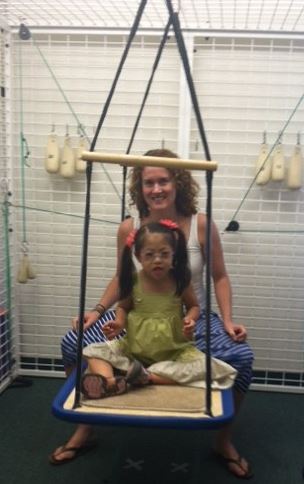PT Corner: A Few Examples of the Importance of Postural Control
by Stacy Menz, DPT, DPT, Board Certified Pediatric Clinical Specialist
 JR is 5-year-old boy and can’t sit in a chair or on the floor for more than 1 or 2 minutes at a time. He’s in constant motion and if he focuses on sitting still he can’t listen or pay attention to anything else. When in a chair he’s sitting on his feet, standing up and down, or moving in his chair so much it’s actually moving the chair itself. When on the floor he is either bumping into his friends or rolling around.
JR is 5-year-old boy and can’t sit in a chair or on the floor for more than 1 or 2 minutes at a time. He’s in constant motion and if he focuses on sitting still he can’t listen or pay attention to anything else. When in a chair he’s sitting on his feet, standing up and down, or moving in his chair so much it’s actually moving the chair itself. When on the floor he is either bumping into his friends or rolling around.
KC is a 5-year-old little girl that can sit in a chair or on the floor, although always seems extremely tired. When at the table she is slouched forward in her chair, or leaning forward and resting her head in her hands or laying her head on the table. When seated on the floor you may see her using a “w” sit or sitting with her legs forward but having to support herself with her hands in back of her to remain in this position.
Both of these kids seem to be at the opposite ends of the spectrum in how they act both seated in a chair and when on the floor, but in actuality could be both experiencing the same postural control issues. They each have their own way to deal with weakened postural control, but may also have other underlying issues that influence the way they act in addition. Postural control allows us better control of our distal extremities (arms and legs) and can also assist in helping us attend to someone or something better when we need to.
In order to compensate for his weakened postural control JR moves excessively. The movement helps him in remaining upright, but can lead to increased distractibility and difficulty in attention. This movement keeps him alert and at an increased arousal level. KC allows her postural control to take over for her instead and she is notably experiencing a lower arousal level when seated. She allows her body to sink back into things and depends on her upper extremities for support in a lot of cases to keep her upright. This lower arousal can lead to inattention as well at times, and she can tune out others around her.
Postural control is extremely important not only in a child’s attention and focus, but also in fine motor. In both JR and KC’s cases, their fine motor abilities can be affected depending on how they are able to sit down. Good postural control is also important in our balance and in helping us navigate our different environments appropriately and safely. There are many ways to work on postural control that are fun and exciting for kids. Here are some to check out.
Great Postural Control Activities:
Kids Yoga
Swimming
Karate
Yoga ball exercises
Animal Walks
Climbing
Featured Guest Columnist: Stacy Menz, DPT, Board Certified Pediatric Clinical Specialist
Stacy, Starfish Therapies’ founder, is a pediatric physical therapist with both a Masters and a Doctorate in Physical Therapy from Boston University and is a board certified pediatric clinical specialist. She stumbled into this field when she realized she would get to play with kids all day long! In reality, she loves making a difference in the lives of kids and their families. In addition to doing rehabilitative work with kids, she also promotes overall wellness and prevention of developmental delays through education. Stacy is actively involved in her professional organizations and is on the editorial board of Impact, the publication of the Private Practice Section of the APTA, and serves on the education committee of the Pediatric Special Interest Group for the California Physical Therapy Association. Stacy and her colleagues are also actively involved in research and have an article submitted for publication.
Please support our contributing authors and visit Starfish Therapies
DUP
PediaStaff is Hiring!
All JobsPediaStaff hires pediatric and school-based professionals nationwide for contract assignments of 2 to 12 months. We also help clinics, hospitals, schools, and home health agencies to find and hire these professionals directly. We work with Speech-Language Pathologists, Occupational and Physical Therapists, School Psychologists, and others in pediatric therapy and education.
